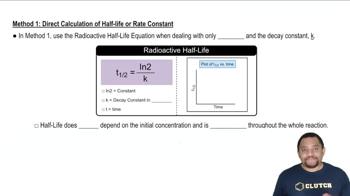Here are the essential concepts you must grasp in order to answer the question correctly.
Radioactive Decay and Half-Life
Radioactive decay is the process by which an unstable atomic nucleus loses energy by emitting radiation. The half-life is the time required for half of the radioactive atoms in a sample to decay. For Radium-226, with a half-life of 1.6 × 10^3 years, this means that after this period, half of the original amount will have transformed into Radon-222.
Recommended video:
Method 1 of Radioactive Half-Life
Ideal Gas Law
The Ideal Gas Law relates the pressure, volume, temperature, and number of moles of a gas through the equation PV = nRT. Here, P is pressure, V is volume, n is the number of moles, R is the ideal gas constant, and T is temperature in Kelvin. This law is essential for calculating the volume of gas produced from the decay of Radium-226 into Radon-222 under specified conditions.
Recommended video:
Stoichiometry of Radioactive Decay
Stoichiometry in the context of radioactive decay involves calculating the amount of product formed from a given amount of reactant based on the decay process. In this case, knowing the initial mass of Radium-226 allows us to determine how much Radon-222 is produced after a certain time, using the decay constant derived from the half-life.
Recommended video:
Rate of Radioactive Decay

 Verified step by step guidance
Verified step by step guidance

